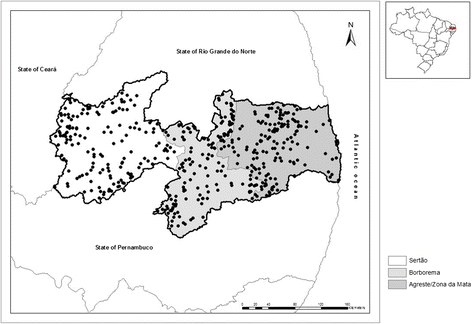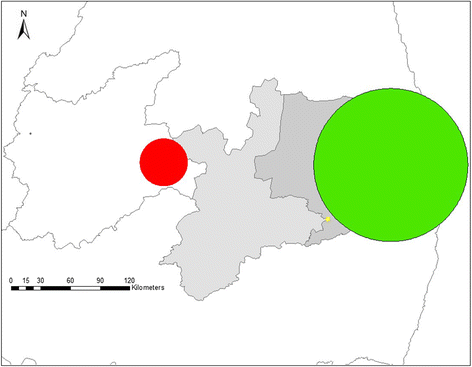Spatial analysis for bovine viral diarrhea virus and bovine herpesvirus type 1 infections in the state of Paraíba, northeastern Brazil
- PMID: 29554912
- PMCID: PMC5859533
- DOI: 10.1186/s12917-018-1412-5
Spatial analysis for bovine viral diarrhea virus and bovine herpesvirus type 1 infections in the state of Paraíba, northeastern Brazil
Abstract
Background: Bovine Viral Diarrhea Virus (BVDV) and Bovine Herpesvirus type 1 (BoHV-1) cause reproductive problems in cattle and restrictions on international trade in animals worldwide. Both infections were detected in cattle herds in the Paraíba state, Northeastern Brazil, however, the spatial distribution and geographic identification of positive herds for these viruses has never been examined. Therefore, the aim of this study was to describe the spatial pattern of apparent prevalence estimate and to identify spatial clustering of positive herds of BVDV and BoHV-1 infections in cattle herds from the state of Paraíba, Northeastern Brazil.
Results: The herd-level prevalence for BVDV and BoHV-1 infections in Paraíba were, respectively, 65.5% (95% CI: 61.1-69.7) and 87.8% (95% CI: 84.5-90.5). The average apparent within-herd prevalence of BVDV was 31.8% and of BoHV-1 was 62.4%. The predicted prevalence was highest (0.42-0.75) for BVDV in the west, north and eastern part of Sertão and in the central and eastern part of Agreste/Zona da Mata. For BoHV-1, the highest predicted prevalence (0.74-0.97) was in some local areas across Sertão and throughout the eastern part of Agreste/Zona da Mata. Six significant clusters were detected for BVDV, a primary cluster covering the eastern Sertão region, with 11 herds, radius of 24.10 km and risk relative (RR) of 2.21 (P < 0.001) and five smaller significant clusters, involving one or two herds in Agreste/Zona da Mata region with a high RR. A significant clustering of BoHV-1 positive herds (P < 0.001) was detected in Agreste/Zona da Mata region with a radius of 77.17 km and a RR of 1.27, with 103 cases. Consistency was found between kriging and SatScan results for identification of risk areas for BVDV and BoHV-1 infections.
Conclusions: The clusters detected contemplated different areas of the state, with BVDV cluster located in the Sertão and BoHV-1 in Agreste/Zona da Mata stratum. Through the risk mapping, it was possible to identify the areas in which the risk is significantly elevated, coincided with areas where there are borders with other states and in which there is a high movement of animals.
Keywords: BVDV; BoHV-1; Cattle; Cluster analysis; Epidemiology; Kriging estimate.
Conflict of interest statement
Ethics approval
The study was approved by the Ethics Committee of the Federal University of Campina Grande, Brazil — protocol number 48–2012.
Consent for publication
Not applicable.
Competing interests
The authors declare that they have no competing interests.
Publisher’s Note
Springer Nature remains neutral with regard to jurisdictional claims in published maps and institutional affiliations.
Figures






Similar articles
-
Epidemiological situation of vesicular stomatitis virus infection in cattle in the state of Paraíba, semiarid region of Brazil.Prev Vet Med. 2018 Nov 15;160:68-75. doi: 10.1016/j.prevetmed.2018.09.027. Epub 2018 Sep 29. Prev Vet Med. 2018. PMID: 30389000
-
Herd-level prevalence and associated risk factors for Mycobacterium avium subsp. paratuberculosis in cattle in the State of Paraíba, Northeastern Brazil.Prev Vet Med. 2015 Sep 1;121(1-2):49-55. doi: 10.1016/j.prevetmed.2015.06.003. Epub 2015 Jun 6. Prev Vet Med. 2015. PMID: 26092721
-
Herd-level seroprevalence and associated risk factors for bovine cysticercosis in the State of Paraíba, Northeastern Brazil.Prev Vet Med. 2017 Jul 1;142:51-57. doi: 10.1016/j.prevetmed.2017.05.008. Epub 2017 May 10. Prev Vet Med. 2017. PMID: 28606366
-
A genetic profile of bovine pestiviruses circulating in Brazil (1998-2018).Anim Health Res Rev. 2018 Dec;19(2):134-141. doi: 10.1017/S1466252318000130. Anim Health Res Rev. 2018. PMID: 30683172 Review.
-
Biology of bovine herpesvirus 5.Vet J. 2010 May;184(2):138-45. doi: 10.1016/j.tvjl.2009.03.035. Epub 2009 May 5. Vet J. 2010. PMID: 19409823 Review.
Cited by
-
Spatial-temporal trends and economic losses associated with bovine abortifacients in central Argentina.Trop Anim Health Prod. 2022 Jul 30;54(4):242. doi: 10.1007/s11250-022-03237-0. Trop Anim Health Prod. 2022. PMID: 35907064
-
Serological profile of respiratory viruses in unvaccinated steers upon their arrival at Brazilian feedlot facilities.Braz J Microbiol. 2023 Dec;54(4):3237-3244. doi: 10.1007/s42770-023-01122-y. Epub 2023 Sep 12. Braz J Microbiol. 2023. PMID: 37700145 Free PMC article.
-
A Systematic Review and Meta-Analysis of Bovine Pestivirus Prevalence and Associated Risk Factors in Latin America.Pathogens. 2025 May 26;14(6):530. doi: 10.3390/pathogens14060530. Pathogens. 2025. PMID: 40559538 Free PMC article. Review.
-
Herd-level based seroprevalence and associated factors for Toxoplasma gondii in cows in the state of Paraíba, Northeastern Brazil.Rev Bras Parasitol Vet. 2023 May 15;32(2):e017222. doi: 10.1590/S1984-29612023025. eCollection 2023. Rev Bras Parasitol Vet. 2023. PMID: 37194788 Free PMC article.
-
Molecular detection and phylogeny of bovine viral diarrhea virus 1 among cattle herds from Northeast, Southeast, and Midwest regions, Brazil.Braz J Microbiol. 2019 Apr;50(2):571-577. doi: 10.1007/s42770-019-00064-8. Epub 2019 Mar 16. Braz J Microbiol. 2019. PMID: 30879262 Free PMC article.
References
-
- Del Fava C, Pituco EM, D’Angelo JL. Herpesvírus bovino tipo 1 (HVB-1): revisão e situação atual no Brasil. Rev Educ Cont Vet Med Zootec2002;5:300–312.
-
- Del Fava C, Arcaro JRP, Pozzi CR, Júnior IA, Fagundes H. Manejo sanitário para o controle de doenças da reprodução em um sistema leiteiro de produção semi-intensivo. Arq Inst Biol. 2003;70:25–33.
-
- Junqueira JRC, Freitas JC, Alfieri AF, Alfieri AA. Reproductive performance evaluation of a beef cattle herd naturally infected with the BoHV-1, BVDV and Leptospira hardjo. Semin: Cien Agrar. 2006;27:471–480.
-
- Rodning SP, Givens MD, Marley MSD, Zhang Y, Riddell KP. Reproductive and economic impact following controlled introduction of cattle persistently infected with bovine viral diarrhea virus into a naive group of heifers. Theriogenology 2012; 10.1016/j.theriogenology.2012.05.031. - PubMed
-
- Newcomer BW, Givens D. Diagnosis and control of viral diseases of reproductive importance: Infectious Bovine Rhinotracheitis and Bovine Viral Diarrhea Vet Clin North Am - Food Anim Pract 2016; 10.1016/j.cvfa.2016.01.011. - PubMed
MeSH terms
Grants and funding
LinkOut - more resources
Full Text Sources
Other Literature Sources

